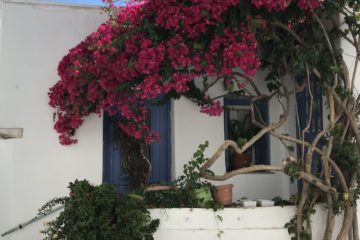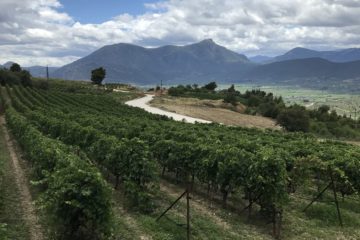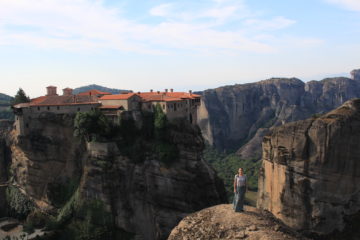The journey from Sihanoukville, Cambodia, to Ho Chi Minh City (aka Saigon, or HCMC for short), Vietnam required an overnight bus and a land border crossing, both firsts for our trip. The overnight bus was a true “sleeper bus” that consisted of completely flat compartments wide enough for two people – so we got to actually lie down flat with provided pillows and sheets! Luxury on wheels. [Editor’s note: Unfortunately, the compartments were so narrow that it was really difficult to sleep shoulder to shoulder in the compartment. Therefore, like true hopeless romantics, we slept head-to-foot for the entire trip. No cuddling here, just utilitarian commuting!] Our sleep was interrupted, however, by a few stops along the way, including one where we had to change busses and another to actually cross the border. The border crossing was somewhat amusing because we had to get off the bus and walk through the Cambodian border to “leave” Cambodia, then get back on the bus, drive about 30 seconds, then get off the bus again to walk across the border to “enter” Vietnam before getting back on again to continue our journey. It all went relatively smoothly, especially for being at about 5 or 6am after a night spent fitfully sleeping on the bus. [Editor’s note: The weird(er) part of the border crossing was the fact that the driver of the bus gathered everyone’s passport and just took care of arranging our Vietnam visas for us at the border. This meant that the border guards were just handing out visas like candy without talking with or even setting eye on the recipients. Super weird and sketchy, but also disconcerting in that we all had to mill about in between borders without our passports for a long stretch.]
Once we reached our HCMC guesthouse, which was a cute narrow building with very steep stairs, we figured that we shouldn’t waste the entire day and decided to go visit the War Remnants Museum dedicated to the Vietnam-American War. (We quickly realized that we needed to stop thinking of it as the “Vietnam War” and start thinking of it as the “American War.”) Getting there involved one of the more bizarre business-model flukes I’ve seen: it seemed a little farther than we wanted to walk, so our guesthouse owner offered to call a car for us using a local Uber-equivalent. We asked him how much it would be and he said, “Oh wow, I guess it’s free! Trips that cost less than $1 in fares are just free.” We assumed there was no way this was true, but his English was basic enough that we figured the driver would just tell us how much to pay. When we arrived at the museum we asked again. The driver pulled up the app and it said “0” in happy green letters. The driver didn’t seem put off by this at all and happily smiled and waved us on our way. [Editor’s note: We felt bad, as though we were stealing or something, so we still tipped the guy roughly $1 (even though tipping isn’t really a thing in Vietnam). It was all bizarre.] We got out of the car feeling like we had somehow discovered some magical loophole in the system, but we’re certainly not complaining! If someone can explain to me the business rationale for this, I’d love to hear it.
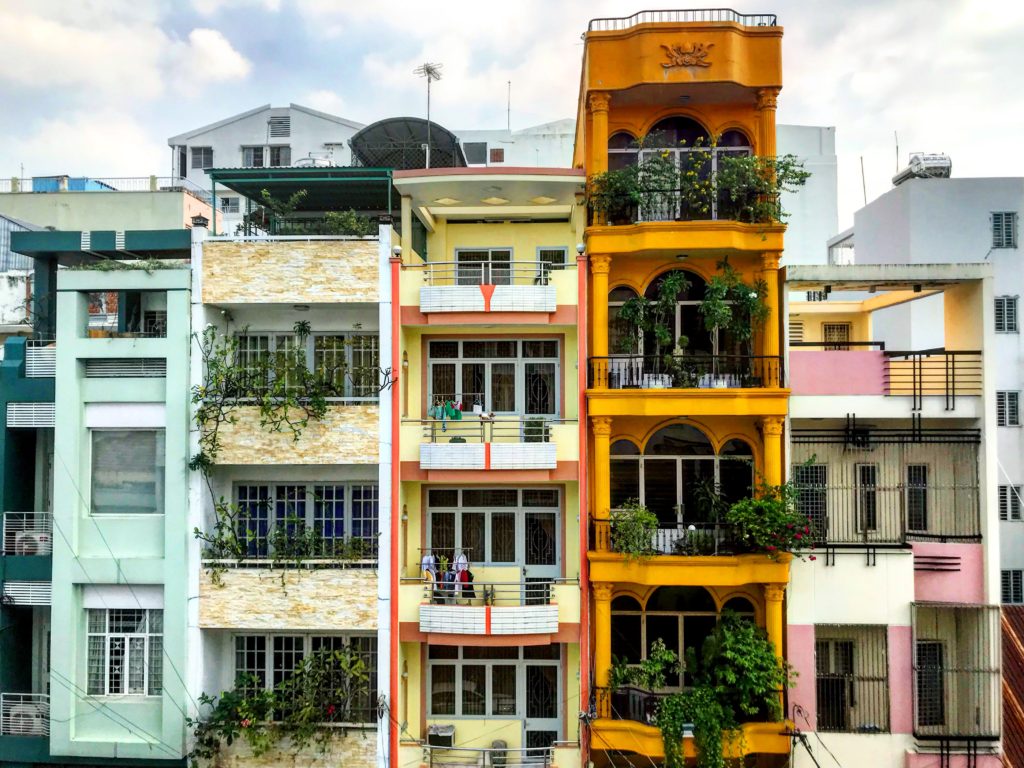
View of cute buildings from our HCMC hotel.
The War Remnants Museum was very well done and depressingly graphic in depicting the horrors of the Vietnam-American war. It felt important to me as an American to visit and learn more about it from this new perspective. The museum was biased and anti-American as is to be expected, but in all fairness did a good job representing the fact that (for example) many Americans opposed the war as well. Overall I left feeling much more informed and glad that we had done the museum but exhausted emotionally and pretty depressed. [Editor’s note: While Jess is totally correct about it being biased and anti-American, the museum was also great about describing the historical circumstances that preceded the war (e.g., the conflict with France and America’s role in financing it) and how the magnitude of the conflict (i.e., bombs dropped, casualties incurred, troops deployed, etc.) compared with other U.S. wars, which was highly informative. It also had some old American artillery, tanks and other weapons, as well as a replica of a prison where U.S. soldiers tortured Vietnamese POWs. Finally, it had a particularly powerful exhibit on wartime photographers, some of their more notable pictures/scenes, and how each of them ended up perishing during the war. All in all, it was a very well done museum that conveyed a side of the war that America likes to brush under the rug.]
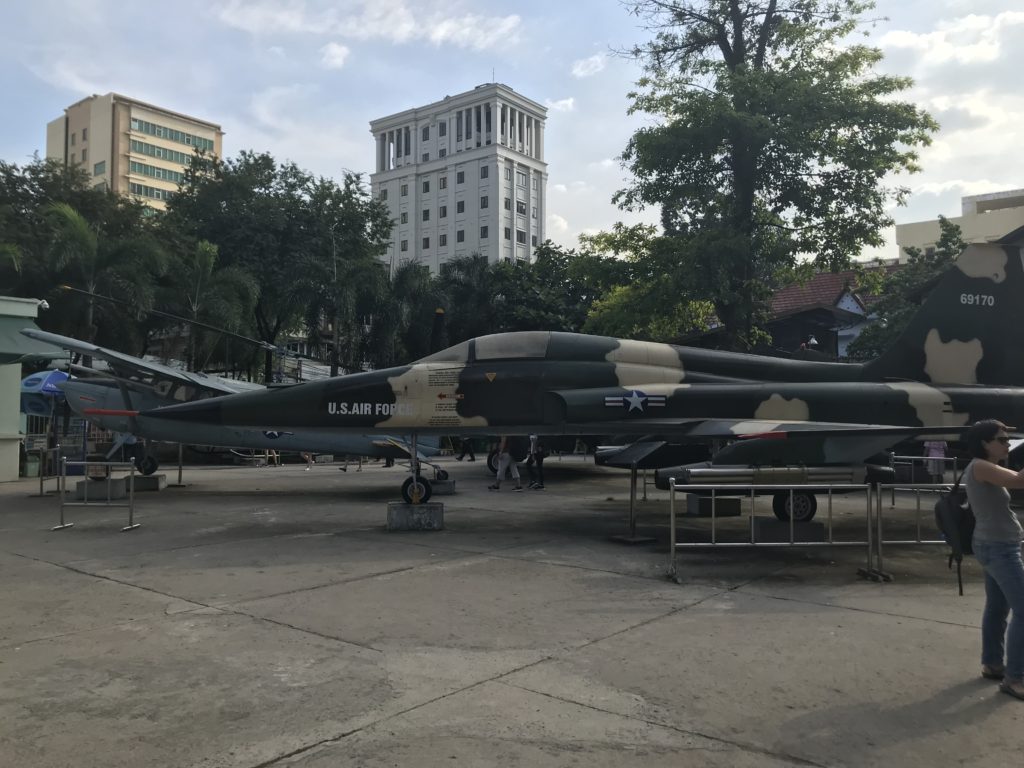
One of the leftover U.S. bomber planes left in Vietnam following the war.
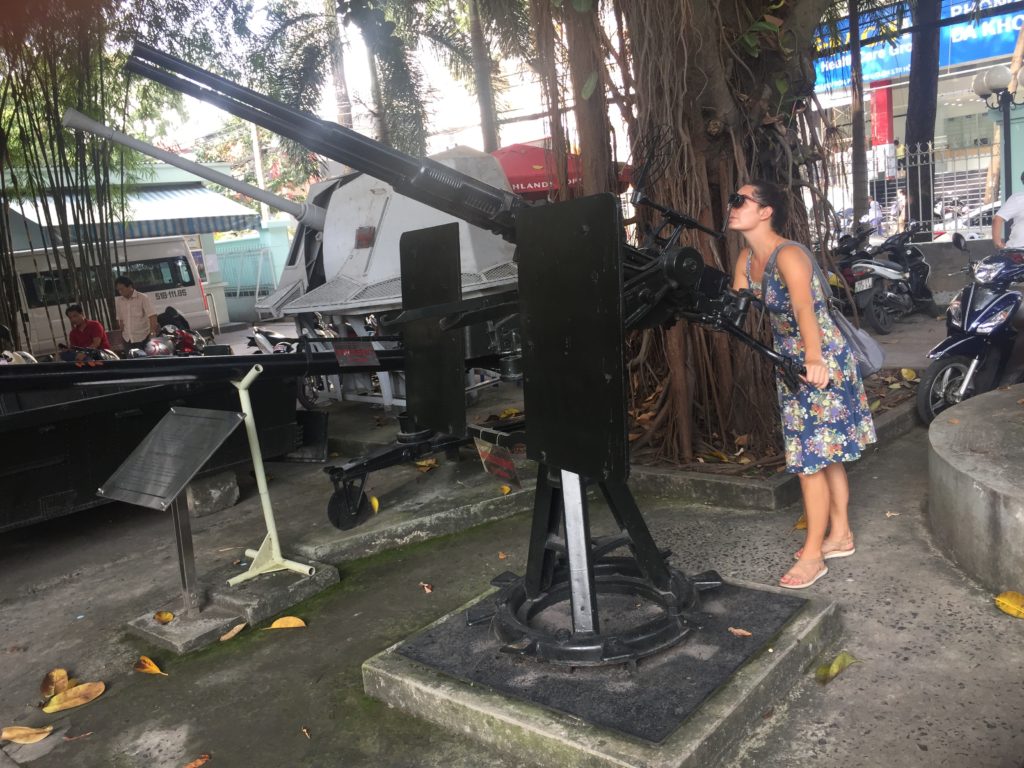
Trying out the scope of one of the standing guns at the War Remnants Museum. I’m sure the U.S. military always envisioned it being used by “soldiers” in sun dresses.
Continuing the war theme, the following day we signed up for an afternoon trip to the Cu Chi Tunnels, which were a series of strategically important underground tunnels near HCMC that the Vietcong used to fight the U.S. during the Vietnam war. It was also a region at a high enough elevation and with the right type of soil to allow for deep tunnel systems to the built, first in the Vietnam-French war and then dramatically expanded and connected in the American War. This tour was better than I had expected since it provided a fascinating look at the tunnels themselves as well as a history lesson in the war, the culture of the people who lived in the region, and why and how their fighting methods were so successful.
As part of the Cu Chi Tunnels tour, we were able to see the entrances to real tunnels, the booby traps that were set for Americans to fall into, and to learn about ways the Vietnamese soldiers escaped detection (e.g., disguising the openings of air vents as termite mounds, stuffing old uniforms of American GIs into tunnel openings to confuse the sniffer dogs that were brought to find them, and wearing “Saigon Shoes” which were cut in reverse so it’d look like you were walking in the opposite direction of your actual footsteps). There was an American tank that had been disabled by a mine still sitting in its original spot and signposts marking bomb depressions in the jungle floor. The highlight towards the end of the tour was being able to climb through a portion of an original tunnel. Though we were told they’ve since widened it for tourists, it was still incredibly narrow. In fact, Rorie’s knees and generally large size couldn’t handle more than 20 meters of it. [Editor’s note: It was crazy. My back was bumping across the top of the tunnel and my legs started cramping after only a few steps. It added new perspective to our tour guide’s comments about how the Vietcong intentionally made the tunnels small so that if American soldiers followed them inside, they’d be too large to move around well and then would just get killed. There was a big emphasis on using the size of Americans against them, as well as using the comparatively diminutive size of Vietnamese soldiers to their benefit.] I was able to finish the entire 100m, which involved climbing up and down in a tunnel about the width of my shoulders. It really gives an incredible respect for the people who spent long periods underground in these tiny spaces. [Editor’s note: These tunnels were incredibly cool and a true highlight. It really gave you a sense of what it must’ve been like during the war. This was enhanced by the shooting range located in the complex where tourists eagerly fired off AK-47s with impunity, which certainly added to the sensation that this was an area where fierce fighting happened. Pretty remarkable.]
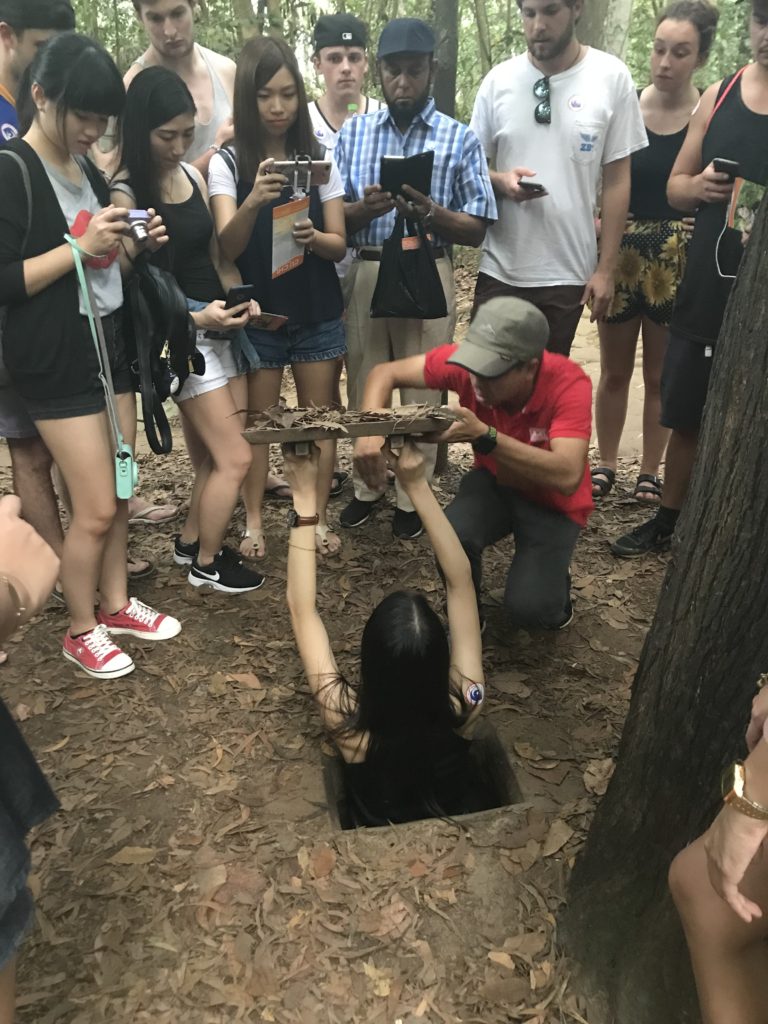
A fellow tourist climbing into one of the disguised entrances to the tunnels.
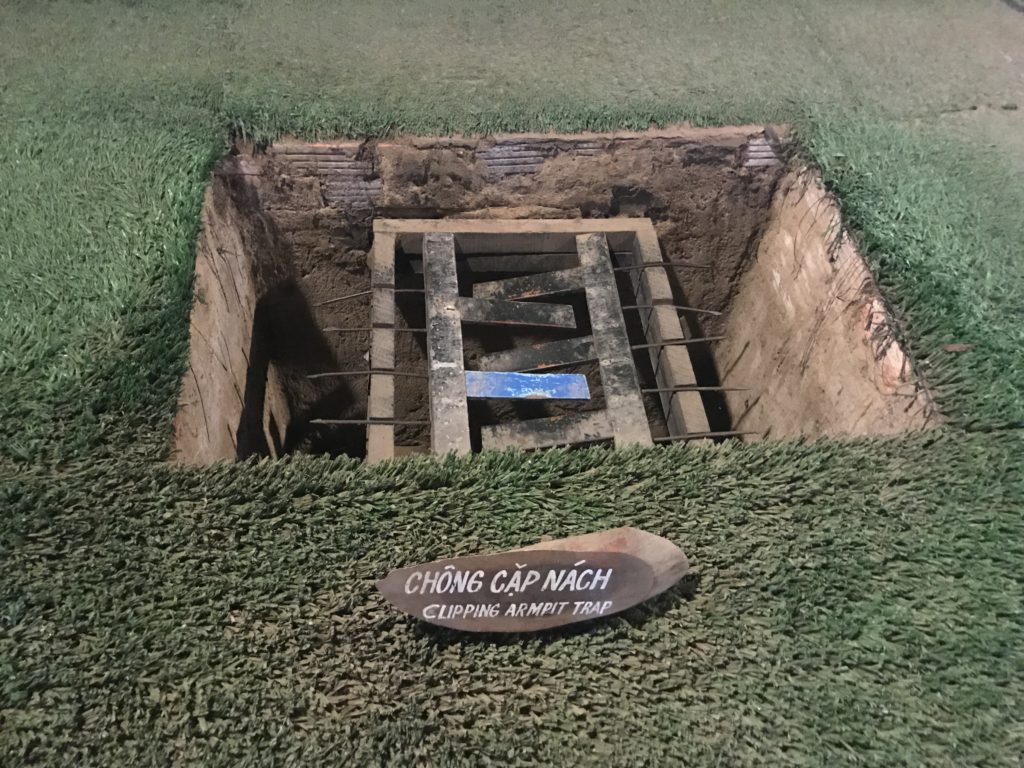
One of the traps (the soldier would fall through the middle and get clenched into the trap) that the Vietcong would use capture/kill unwitting U.S. soldiers during the war.
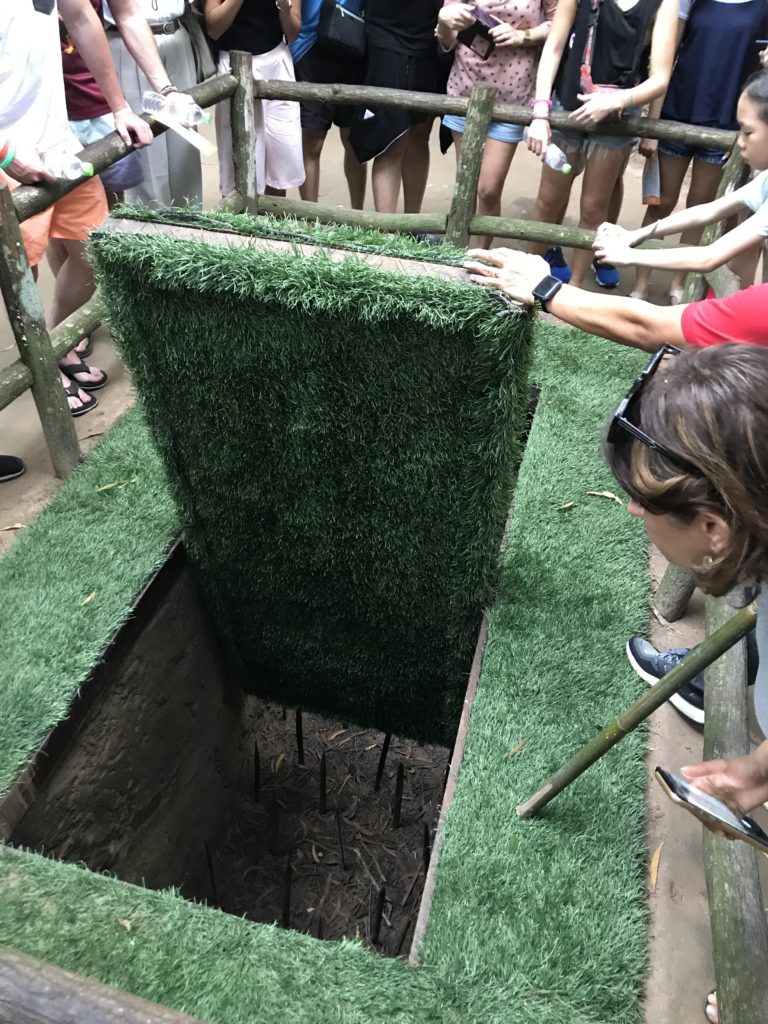
A revolving door trap where a soldier would fall in, die from all the spikes and then the door would flip back upright to lure in another soldier.
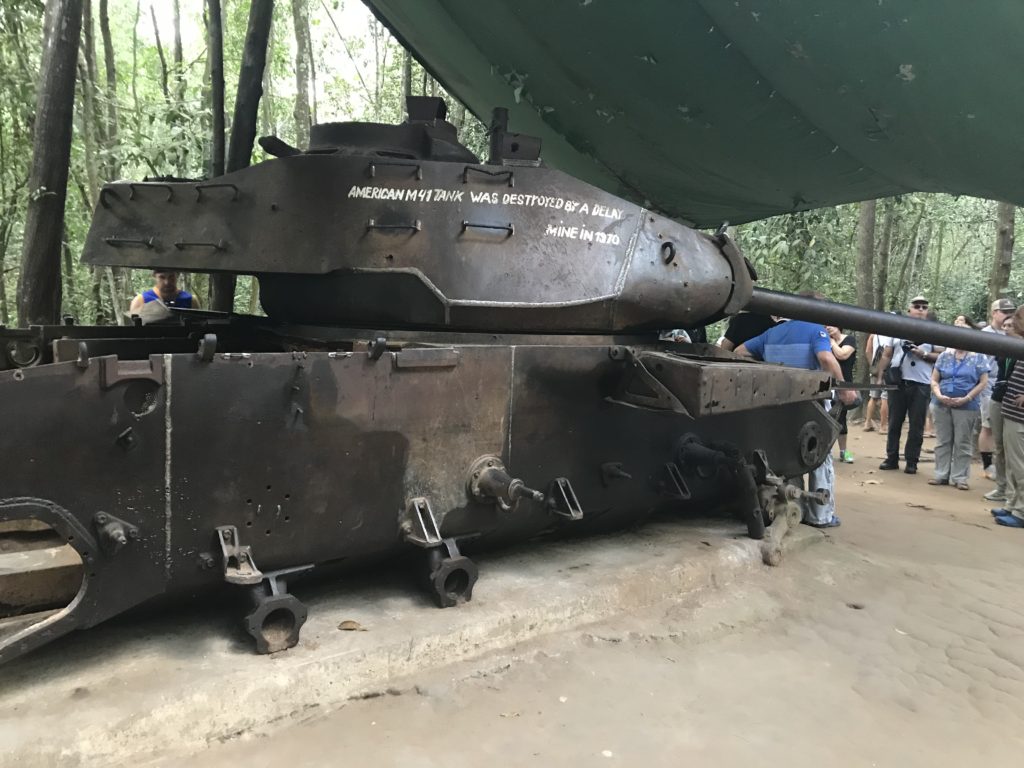
A U.S. tank that the Vietcong destroyed with a homemade “delayed explosion” land mine, which remains in the original spot where it exploded.

Rorie crouching in the Cu Chi Tunnels, proving that oversized Americans were ill-suited to fight in the Vietnam jungle.
Besides the War Remnants Museum and the Cu Chi Tunnels, we wandered around the enormous Ben Tranh market both in the day and at night, including a very cool night food stall area with live music that reminded me of the Smorgasburg food trucks back in New York City. [Editor’s note: Most importantly, after searching through countless markets across three countries, I finally found the first stalls to actually carry and sell Utah Jazz NBA jerseys! Normally they just have big name players (e.g., Kobe Bryant) and would look at me in confusion when I eagerly gestured to the Jazz logo on my cap, so this was a huge win. I bought a $10 counterfeit Rudy Gobert jersey to celebrate this victory. The Jazz promptly went on a 4 game losing streak as soon as I started wearing it, but whatever. Minor detail.] We also walked up and down Bui Vien, the main backpacker street, and ate lots of pho (entrée-sized bowls of soup full of noodles, meat and other items) and banh mi (delicious subs made in French baguettes by street vendors that sell for less than $1).
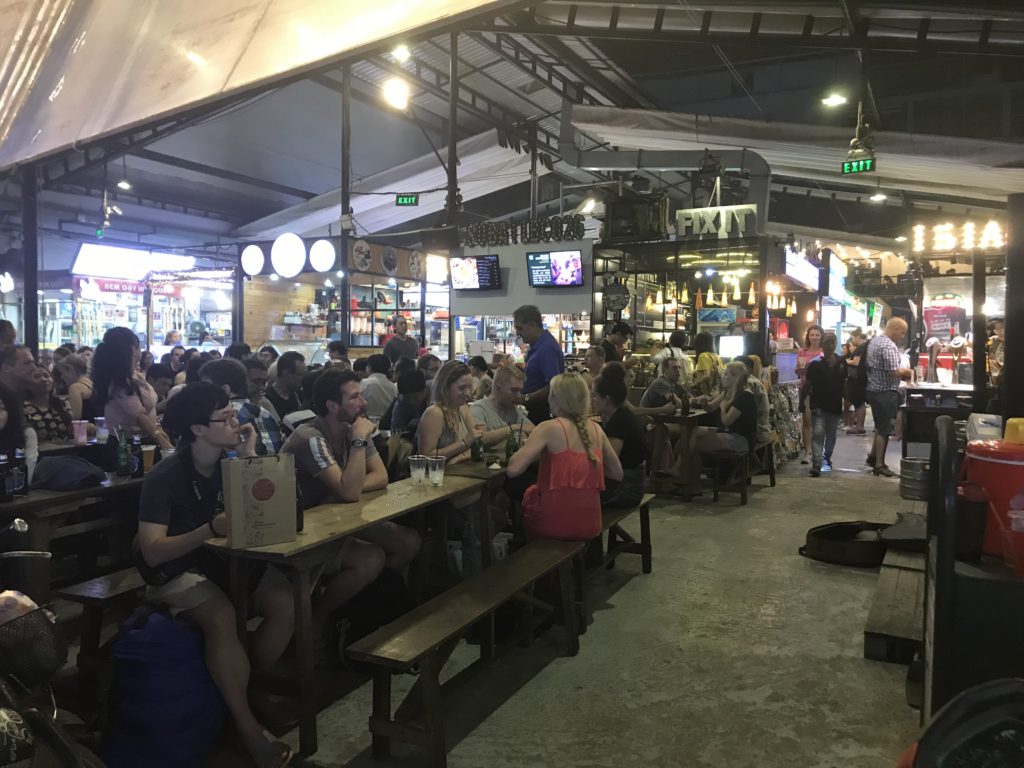
The cool night market where we were able to try a bunch of interesting foods from around Vietnam.

A typical stall in the Vietnamese markets, with a vendor surrounded by all kinds of fabrics and items.
As this was our first stop in country #3 of our trip, here are a few of my initial observations of Vietnam:
- HCMC is the largest and busiest city we’ve visited since leaving China, and the traffic consists of ~80% motorbikes that do not obey any traffic signals, laws, or conventions. This made it extremely difficult to cross streets, as they were generally several lanes wide and completely full of a never-ending stream of vehicles. I could do with a few more pedestrian concessions, personally. [Editor’s note: While chaotic, this has afforded us an excellent opportunity to work Jess’s street crossing skills. Most of the time she just grabs my arm like a wary yiayia and has me guide her across, but sometimes she leads the charge! These are big moments and we’ve taken to acknowledging her accomplishments when they happen.]
- The food is awesome in Vietnam. We had a few dishes we liked in Cambodia, but I generally felt there was a lack of variety and most of my choices were fried. In Vietnam we have amazing pho and lots of other items that tasted fresh and clean while still being delicious and flavorful. I’m very excited to keep eating. [Editor’s note: I started out more excited about the food in Vietnam, but that has slightly dissipated with time. The food is better than Cambodia, but I’m still refraining from becoming full-blown excited until we end up in Thailand. That’s where the real fun begins.]
- Of the 3 countries so far (China, Cambodia, Vietnam), Vietnam has the most built-up backpacker infrastructure for westerners by far. Whereas China catered almost exclusively to other Chinese tourists, and Cambodia has areas that are touristy (like Angkor Wat), Vietnam is a well-trodden path for people traveling from one end of the country to the other by bus or bike, and on a budget. It’s extremely easy to get a cheap bus ticket to the next city and doesn’t really require planning ahead at all, which has been perfect for us. [Editor’s note: It’s almost too easy to get around, which is weird. There’s effectively no challenge whatsoever involved with travelling here, which is simultaneously nice and kinda boring. We need some struggles, like the good old days in China!]
- Coffee remains a challenge. It’s plentiful in Vietnam, and there are tons of coffee shops, but many of them only sell “Vietnamese coffee” that is full of sugar and condensed milk. I tried specifically ordering coffee with no sugar one time and was told “We don’t have that. There is sugar in it already.” Luckily, with enough tourist presence, we’ve generally been able to find lattes or other non-local coffee preparation when we needed to.
- [Editor’s note: I’ll add one more item, since I think people find it interesting. As compared to Cambodia and China, Vietnam is far and away the cheapest country we’ve visited. Meals are roughly $3 per person, private rooms are as low as $9/night and beers are $0.50/each, just to give you a sense of where costs fall. On a normal day where we’re not doing any tours or activities, I’d say that our expenditures per person are roughly between 1/2 and 1/3 as much as they were in China. It’s awesome.]
Our time in HCMC also marked eight weeks of international travel since we landed in China and fourteen weeks since we left NYC! In celebration of not killing each other in two months of 24/7 companionship while travelling, Rorie and I decided to split off for the next few days and explore two different beach towns in Vietnam – I will go to Mui Ne and he will go to Nha Trang. We’ll see what there is to see, have some independent time, and then meet up again in a few days in Da Lat in the mountains.
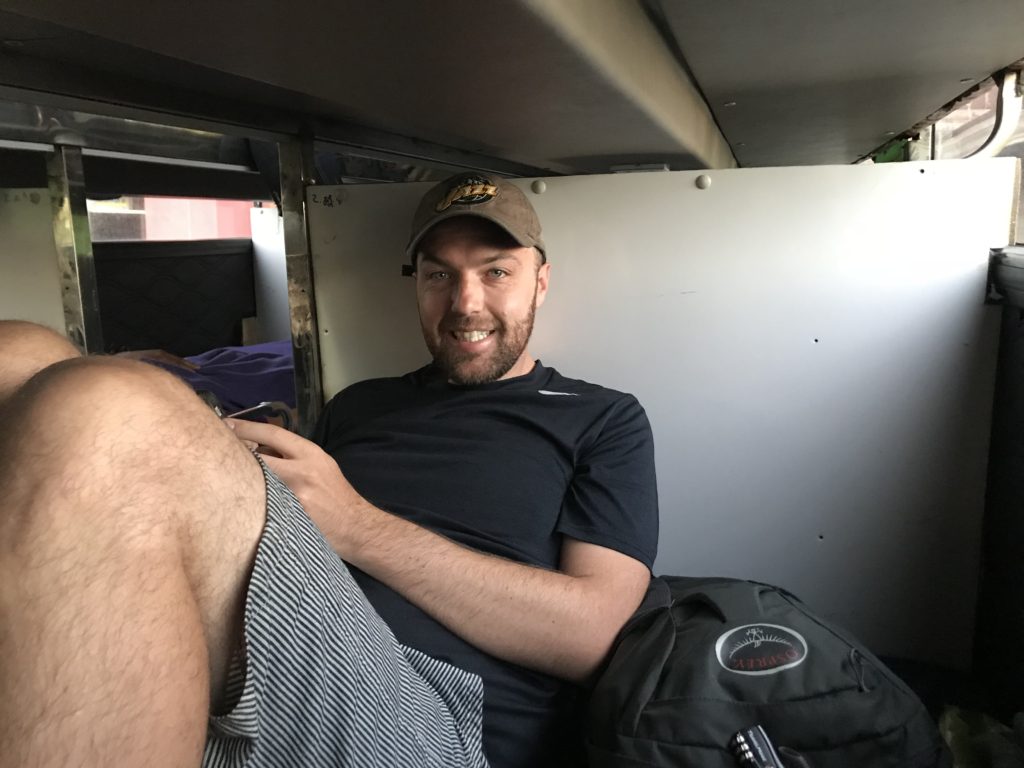
My view for roughly 15 hours on the sleeper bus.
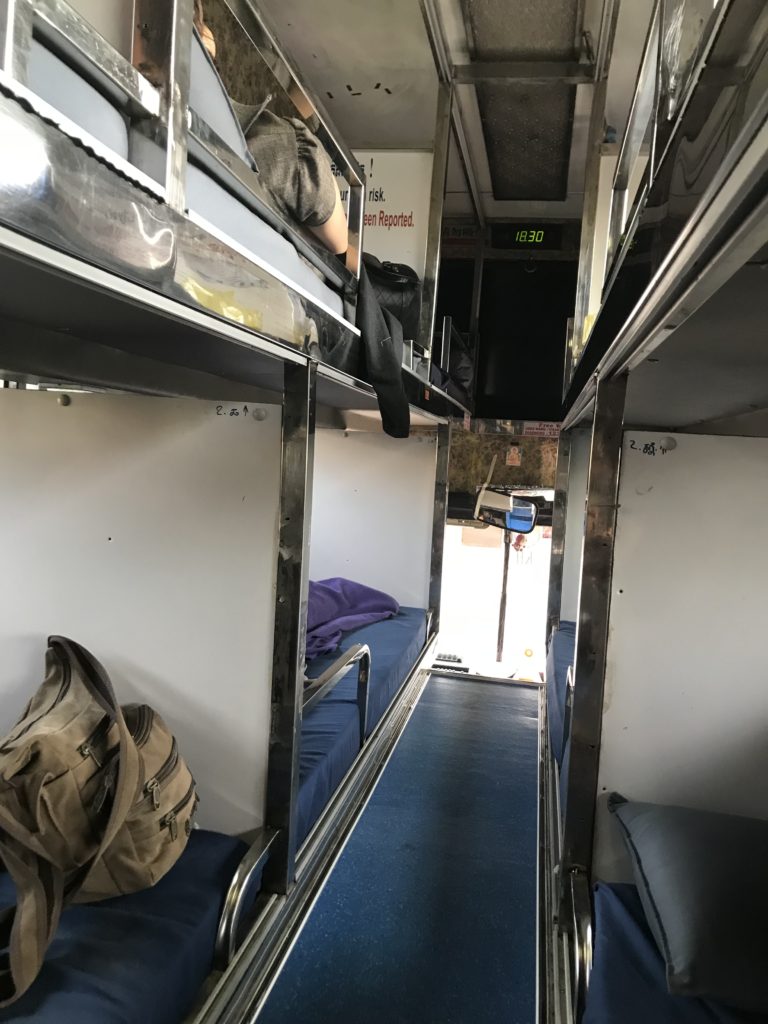
Another view of the types of arrangements that are offered in a cross-border overnight sleeper bus.
